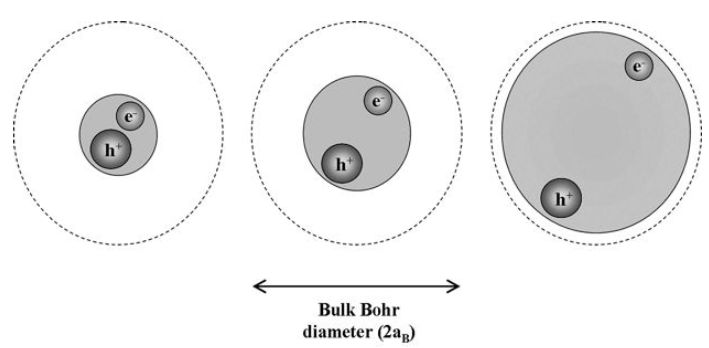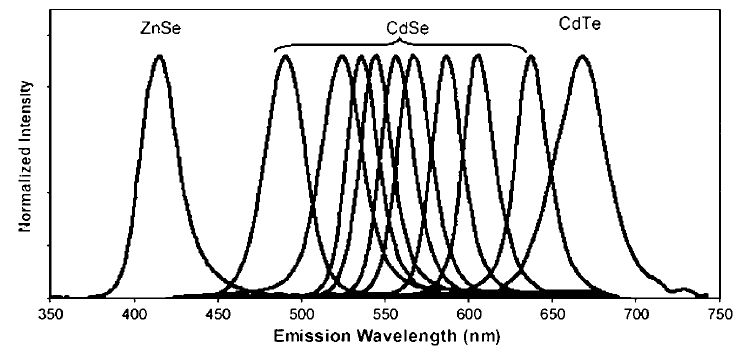
Semiconductor Quantum Dots
 المؤلف:
John M Walker and Ralph Rapley
المؤلف:
John M Walker and Ralph Rapley
 المصدر:
Molecular Biology and Biotechnology 5th Edition
المصدر:
Molecular Biology and Biotechnology 5th Edition
 الجزء والصفحة:
الجزء والصفحة:
 2-12-2020
2-12-2020
 1110
1110
Semiconductor Quantum Dots
1. Quantum Confinement Effects
Quantum dots (qdots) are nanometer-sized crystalline clusters (1–10 nm) made from a variety of semiconductor materials. Qdots are characterized by large absorption spectra, but narrow and very symmetric emission bands with full widths at half-maximum of 25–35 nm. The emission bands can span the spectrum from the ultraviolet to the infrared (365–1350 nm) depending on the size of the dot. These materials typically have a large absorption cross-section and long fluorescence lifetimes (>10 ns). Further, they possess a photostability many orders of magnitude greater than conventional organic fluorophores. Given their advantages relative to organic fluorophores, qdots have emerged as a new class of fluorescent probes for biological applications.

Figure 1 Quantum confinement. As the size of a nanocrystal increases the bandgap decreases, similar to the classic particle in a box.
The origin of the unique size-dependent optical and electronic properties of semiconductor nanoparticles arises from the particle’s nanoscale structure. When a photon of sufficient energy [hv>Eg (bandgap)] is absorbed by a semiconductor, an electron is excited out of the valence band into the conduction band, creating an electron–hole pair. In bulk semiconductors, the average distance between the electron and the hole is called the bulk Bohr radius, aB. As the size of the crystal decreases to approach the bulk Bohr radius, the energy levels become discrete and boundary conditions are imposed on the wavefunctions of the two charges. This condition results in the phenomena of quantum confinement (Figure 1).
To a first approximation, quantum confinement exhibited in nanocrystals follows behavior similar to that of the classic particle-in-a-box problem. For a particle in a box, the energy difference between the conduction and the valence bands is related to the inverse square of the nanocrystal radius:

where h is Planck’s constant (6.626*10-34 J s), m is mass and R is the nanocrystal radius. As the size of the nanocrystal increases, the bandgap narrows and both the absorption and fluorescence wavelengths shift towards the red (Figure 2). Capitalizing on this quantum confinement permits exceptional tunability of absorption and emission wavelengths by simply changing the size of the nanocrystal.

Figure 2. Emission spectra of semiconducting quantum dots. The variable CdSe spectra illustrate the blue to red shift that occurs with increasing particle size.
2. Biotechnological Applications of Fluorescent Semiconductor Quantum Dots
With commercial sources of qdots available and a growing variety of surface chemistry strategies for functionalization, the successful application of qdots to a diverse range of imaging challenges has grown.
These include such applications as immunofluorescence assays, biotechnology detection, live cell imaging, single-molecule biophysics and in vivo animal studies. Although qdots represent a powerful tool for some imaging applications, it must be remembered that a square peg will not fit into a round hole. The examples below highlight some of the most suitable applications of qdots and discuss some of the challenges that researchers are currently facing.
The broadband adsorption and narrow, symmetrical and size-tunable emission bands of qdots facilitate their use for multiplexed detection of signals. The important consequence of this broad absorption is that one wavelength of light can excite multiple qdots, each with different emission maxima. Highly robust commercial preparations of CdSe/ZnS qdots, emitting in the visible spectrum, match the detection range of many typical imaging devices. Further, with the elimination of many chromatic aberration and alignment issues encountered with standard fluorescence microscopy, colocalization studies are possible. A recent example of dynamic multicolor imaging can be seen in the visualization of viral proteins in the membrane of an infected host cell. Benzten et al. directly labeled both the F (fusion) and G (attachment) proteins of respiratory syncytical virus (RSV) using qdots with the primary antibody attached covalently to the surface. Using confocal laser scanning microscopy, the F and G proteins were co-localized on the surface of the infected cells. The sensitivity of detection of the F protein with the qdots as a function of plaque-forming units (PFUs) showed a linear response at 18 h over a range of 35–110 PFU per well (multiplicity of infection 0.0032). After longer periods of time (360–42 h), lower rates of infection could be detected as a result of the inherent viral replication in culture. In terms of absolute sensitivity, the F and G proteins could be detected as early as 1 h post-infection, on a
par with the most sensitive RT-PCR methods. There are several potential applications arising from the increased photostability of qdots relative to organic dyes. High fluorescence photostability allows for the repeated imaging of immunostained samples that will maintain their crisp, high-resolution three-dimensional definition. For example, pathology samples or culture assays can be readily reviewed without worry about loss of signal that is a limiting factor with organic dyes. The photostability is also a clear advantage in live cell imaging experiments, where cells or single molecules need to be monitored over hours or days. Dubertret et al. demonstrated cell lineage tracing by
injecting qdots in a single Xenopus frog cell during an early embryonic stage and followed their fate during subsequent development over days. Similarly, the lateral dynamics of qdot-labeled glycine receptors has been monitored in neuronal membranes as a function of time. Qdots have also been surprisingly successful for in vivo animal imaging in a number of species. These deep tissue studies have imaged lymph nodes, vascular markers, blood vessels and grafted tumors. The utilization of a polyethylene glycol (PEG) co-ligand is a common approach in all of these studies to enhance circulation time and reduce non-specific binding. With the advent of NIR CdTe/CdSe qdots, lymph nodes were imaged 1 cm deep in tissue. As synthetic advances in the production and functionalization of both NIR and IR qdots improve, the properties of these probes combined with time-gated microscopy methods, to reduce background autofluorescence, may result in detection sensitivities that rival those of radiolabeled probes. Although the above examples highlight the promise of qdot applications as biological probes, it is important also to mention some of their challenges. Foremost, is the difficulty of targeting these probes to the cytoplasm. Despite some interesting attempts using membrane translocating peptides, electroporation or transfection reagents, qdots tend to accumulate in vesicles or appear non-homogeneously distributed in the cytoplasm. Currently, there has been no real success in overcoming this technique for the convenient imaging of cytosolic targets Another application that has not met with complete success due to the inherent properties of qdots is the development of FRET sensors. The narrow and tunable emission characteristics of qdots can be exploited to customize donor emission in fluorescence (Fo¨ ster) resonance energy transfer (FRET) assays between qdot donors and fluorescent organic dye acceptors.13 Such assays convey only qualitative information about molecular associations in ensemble measurements. Unfortunately, there are several hurdles to be cleared before more quantitative measurements can be made by FRET. The first challenge is that minor variations in the surface defects of individual qdots can introduce significant spectral heterogeneity. The second challenge is the environment-dependent intermittency of qdot fluorescence – the so-called blinking phenomenon.
Qdot blinking is associated with charge trapping and untrapping at surface defect sites resulting in bright and dark states. Such blinking results in the random loss of distance information on all time scales and can impact the energy transfer efficiency. With improvements in synthetic strategies to eliminate blinking and improve spectral homogeneity, qdots may eventually become effective FRET nanoscale biosensors.
 الاكثر قراءة في مفاهيم التقنية الحيوية النانوية
الاكثر قراءة في مفاهيم التقنية الحيوية النانوية
 اخر الاخبار
اخر الاخبار
اخبار العتبة العباسية المقدسة


